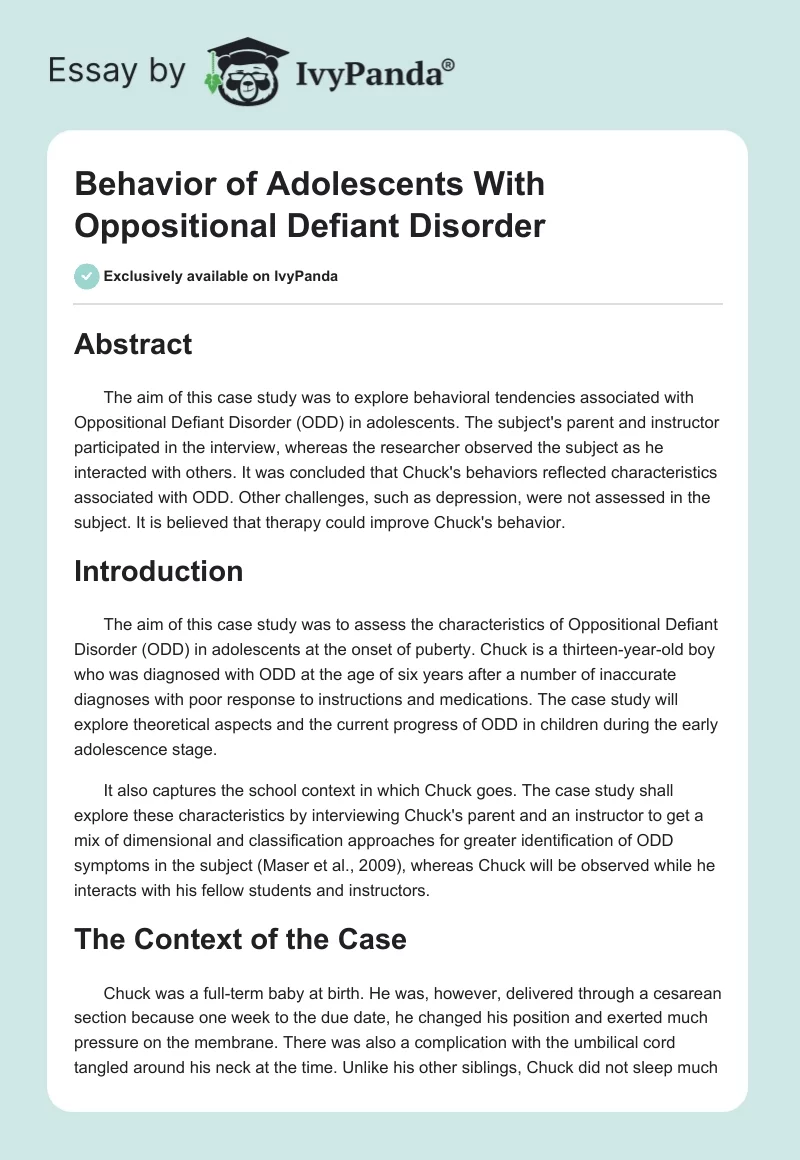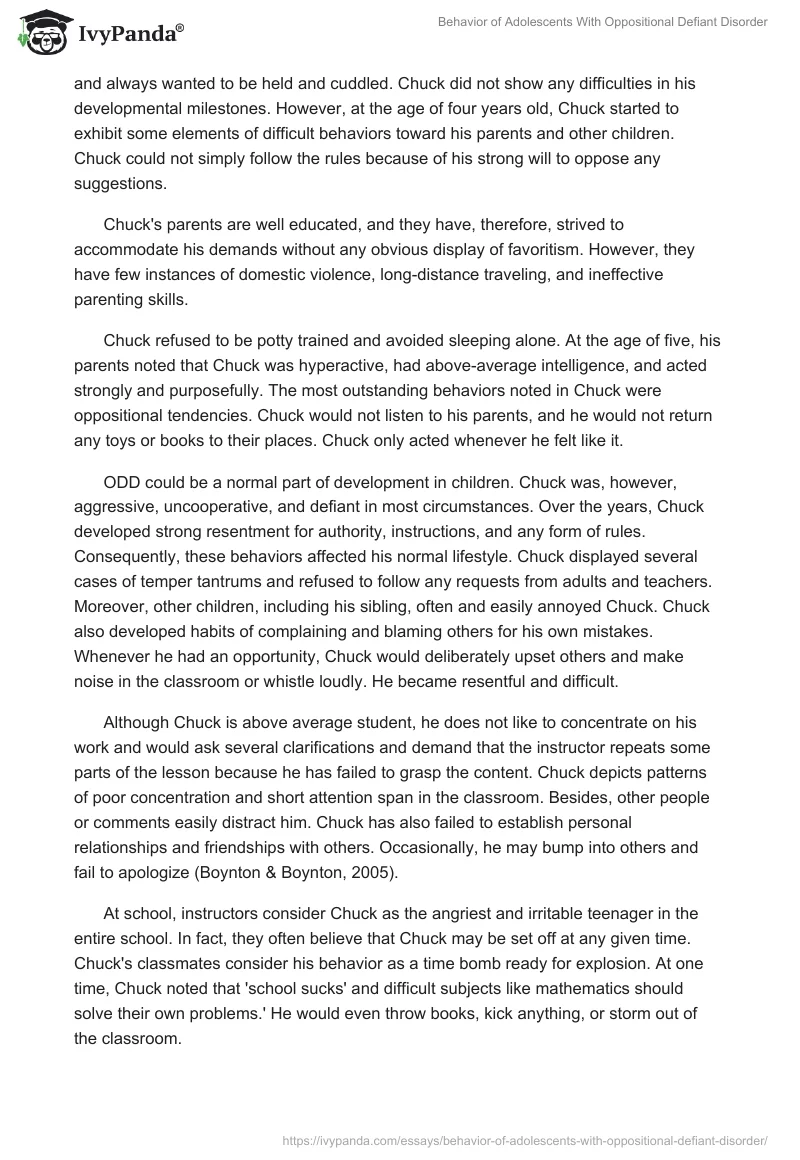Abstract
The aim of this case study was to explore behavioral tendencies associated with Oppositional Defiant Disorder (ODD) in adolescents. The subject’s parent and instructor participated in the interview, whereas the researcher observed the subject as he interacted with others. It was concluded that Chuck’s behaviors reflected characteristics associated with ODD. Other challenges, such as depression, were not assessed in the subject. It is believed that therapy could improve Chuck’s behavior.
Introduction
The aim of this case study was to assess the characteristics of Oppositional Defiant Disorder (ODD) in adolescents at the onset of puberty. Chuck is a thirteen-year-old boy who was diagnosed with ODD at the age of six years after a number of inaccurate diagnoses with poor response to instructions and medications. The case study will explore theoretical aspects and the current progress of ODD in children during the early adolescence stage.
It also captures the school context in which Chuck goes. The case study shall explore these characteristics by interviewing Chuck’s parent and an instructor to get a mix of dimensional and classification approaches for greater identification of ODD symptoms in the subject (Maser et al., 2009), whereas Chuck will be observed while he interacts with his fellow students and instructors.
The Context of the Case
Chuck was a full-term baby at birth. He was, however, delivered through a cesarean section because one week to the due date, he changed his position and exerted much pressure on the membrane. There was also a complication with the umbilical cord tangled around his neck at the time. Unlike his other siblings, Chuck did not sleep much and always wanted to be held and cuddled. Chuck did not show any difficulties in his developmental milestones. However, at the age of four years old, Chuck started to exhibit some elements of difficult behaviors toward his parents and other children. Chuck could not simply follow the rules because of his strong will to oppose any suggestions.
Chuck’s parents are well educated, and they have, therefore, strived to accommodate his demands without any obvious display of favoritism. However, they have few instances of domestic violence, long-distance traveling, and ineffective parenting skills.
Chuck refused to be potty trained and avoided sleeping alone. At the age of five, his parents noted that Chuck was hyperactive, had above-average intelligence, and acted strongly and purposefully. The most outstanding behaviors noted in Chuck were oppositional tendencies. Chuck would not listen to his parents, and he would not return any toys or books to their places. Chuck only acted whenever he felt like it.
ODD could be a normal part of development in children. Chuck was, however, aggressive, uncooperative, and defiant in most circumstances. Over the years, Chuck developed strong resentment for authority, instructions, and any form of rules. Consequently, these behaviors affected his normal lifestyle. Chuck displayed several cases of temper tantrums and refused to follow any requests from adults and teachers. Moreover, other children, including his sibling, often and easily annoyed Chuck. Chuck also developed habits of complaining and blaming others for his own mistakes. Whenever he had an opportunity, Chuck would deliberately upset others and make noise in the classroom or whistle loudly. He became resentful and difficult.
Although Chuck is above average student, he does not like to concentrate on his work and would ask several clarifications and demand that the instructor repeats some parts of the lesson because he has failed to grasp the content. Chuck depicts patterns of poor concentration and short attention span in the classroom. Besides, other people or comments easily distract him. Chuck has also failed to establish personal relationships and friendships with others. Occasionally, he may bump into others and fail to apologize (Boynton & Boynton, 2005).
At school, instructors consider Chuck as the angriest and irritable teenager in the entire school. In fact, they often believe that Chuck may be set off at any given time. Chuck’s classmates consider his behavior as a time bomb ready for explosion. At one time, Chuck noted that ‘school sucks’ and difficult subjects like mathematics should solve their own problems.’ He would even throw books, kick anything, or storm out of the classroom.
Chuck’s parents and teachers are worried a lot because of the onset of puberty. They fear that Chuck’s behavior could worsen as he progresses into adolescence. As a result, Chuck was referred to a therapy center because his parents and teachers have failed to cope with his behaviors. Chuck will start his therapy on ODD soon.
Literature Review
The main causes of ODD have remained unknown, but studies have identified possible causes or risk factors as both environmental and biological (Jacobs et al., 2010). Studies have shown that the quality of a family could contribute to the development of ODD. These are mainly poor parenting styles, child neglect, domestic violence, substance and alcohol abuse, physical and sexual abuse. In addition, children may also develop ODD due to divorce, stress, or death within the family. Other children use ODD to deal with their depression, rules, or strict requirements in behaviors.
Studies have associated depression alongside other emotional, social, and behavioral challenges with ODD in adolescents (Jacobs et al., 2010). These factors could be responsible for depressive conditions and conduct disorders in teenagers. Jacobs et al. (2010) noted, “Prevalence rates of oppositional defiant disorder (ODD) have ranged between 3.2 and 13.3% for boys and between 1.4 and 9.4% for girls” (p. 559). Depression could co-occur with other behavioral problems, and therefore the condition has resulted in a public health concern because of the related cases of suicide. Still, a study established that “70% of adolescent suicide victims met criteria for both a mood disorder and an externalizing disorder” (Jacobs et al., 2010).
It is imperative to note that ODD may have mixed symptom presentations like other disruptive and depressive disorders. Negative outcomes of depression show similar characteristics as ODD common in other disruptive behavior disorders. The availability of both cases in an individual normally causes elevated functional impairment and different behavior challenges, such as problematic school behaviors, social problems, and poor relationships with colleagues. According to Stringaris and Goodman, oppositionality in teenagers depicts three aspects, which include irritable, hurtful, and headstrong (Stringaris & Goodman, 2009). It is important to understand oppositionality and their impacts on the lives of teenagers because studies have shown that it has strong associations with psychopathology in adulthood (Nock, Kazdin, Hiripi, & Kessler, 2007).
Jacobs et al. (2010) noted that adolescents with depression and other disruptive behavior disorders had high cases of oppositionality, which were often difficult to treat. These authors established that the best approaches to managing oppositionality in youth required multiple interventions, including cognitive behavior therapy (CBT), fluoxetine, or a combination of both because of co-occurring oppositionality in adolescents. Therefore, cognitive therapies and antidepressant medication were effective in reducing the adverse effects of oppositionality in youths.
Methodology
An interview was conducted to gather data that would help in understanding ODD in Chuck. Chuck’s parents and an instructor participated in this face-to-face interview. The subject was observed as he interacted with other students and teachers at school.
Findings
From the results of the interview, Chuck showed characteristics associated with the oppositional defiant disorder (ODD) as identified in the case context. For instance, Chuck’s teacher noted that he was easily annoyed and could annoy his classmates during class discussions and group works. Chuck would refuse to listen to the class secretary, follow simple class rules, and argue with teachers about assignments. In fact, Chuck was fond of naming other classmates whom he thought were responsible for noisemaking.
Chuck’s mother noted that during his early childhood, Chuck would not respond when called or return books to shelves. At one time, Chuck told his mother, “Mum, you can simply return the book by yourself and save your energy.” This is a major characteristic of ODD – stubbornness in children. Chuck likes to touch and resent other children, particularly if they oppose his behaviors. He has harsh words when upset and can set off at the slightest provocation. Chuck’s mother understands his son’s temper tantrums and tendencies to fight other kids or seek revenge. The boy tends to manipulate his classmates with a promise of protection if they do not oppose him. Chuck’s mother claims that “my boy tends to oppose opinions from his father or me.” Studies show that such tendencies are consistent in children with ODD.
The instructor claimed that “Chuck is the angriest boy in my class and perhaps the whole school and at one time, he told me that school and assignments suck.” Moreover, Chuck could not concentrate on school despite his abilities to score above average marks. Consequently, his performance has started to decline due to a lack of concentration and a short attention span. The instructor and his parents noted that such behaviors were persistent and occurred frequently. In addition, they affected his learning activities because he was easily distracted.
Results from observing Chuck during his interaction with other learners indicated that Chuck was feared and had poor relationships with them. At one time, Chuck bumped into a group of girls, and he started to giggle as the girls dispersed. In the Classroom, Chuck showed that he had not adjusted to the lesson because he could be heard asking, “What lesson is it after this short break?”.
Failure to adjust his behaviors and interaction with others at home and school has prompted his parents and the instructor to seek help from a therapy center. There is fear that Chuck’s ODD alongside the adolescence stage could have adverse effects in his life if he does not get professional intervention.
Conclusion
The school and home provided ideal locations to observe ODD in Chuck. From the interview and observation, one may conclude that Chuck depicts characteristics associated with ODD. The researcher did not directly interview Chuck because he did not know how Chuck would react when asked questions about his behaviors or relationships with others. Therefore, other studies should focus on the ODD subject directly, particularly if they are close. In addition, this study did not explore other behavioral disorders or depression.
References
Boynton, M., & Boynton, C. (2005). Educator’s Guide to Preventing and Solving Discipline Problems. Alexandria, VA: Association for Supervision and Curriculum Development. Web.
Jacobs, R., Becker-Weidman, E., Reinecke, M., Jordan, N., Silva, S., Rohde, P., & March, J. (2010). Treating Depression and Oppositional Behavior in Adolescents. Journal of clinical child and adolescent psychology, 39(4), 559–567. Web.
Maser, J., Norman, S., Zisook, S., Everall, I., Stein, M., Schettler, P., & Judd, L. (2009). Psychiatric nosology is ready for a paradigm shift in DSM–V. Clinical Psychology: Science and Practice, 16(1), 24–40. Web.
Nock, M. K., Kazdin, A. E. , Hiripi, E., & Kessler, R. C. (2007). Lifetime prevalence, correlates, and persistence of oppositional defiant disorder: Results from the National Comorbidity Survey Replication. Journal of Child Psychology and Psychiatry, 48(7), 703–713. Web.
Stringaris, A., & Goodman, R. (2009). Three dimensions of oppositionality in youth. Journal of Child Psychology and Psychiatry, 50(3), 216–223. Web.
Appendix
Interview Questions
- Could you explain some behaviors that you have observed in Chuck since childhood or since he joined your class/school?
- Have you noticed any significant changes in Chuck’s behavior since the onset of puberty?
- What are some of the interventions you have tried on Chuck?


